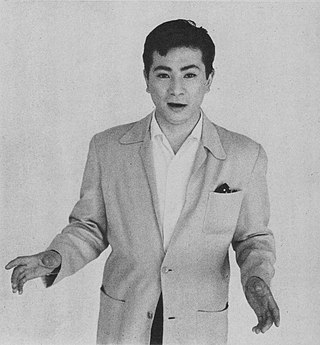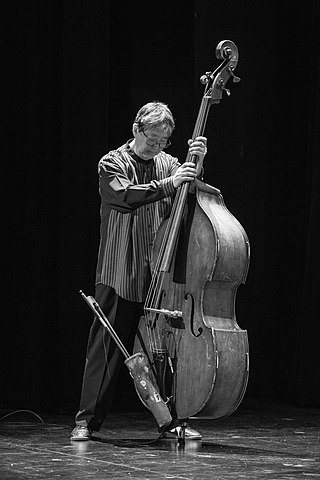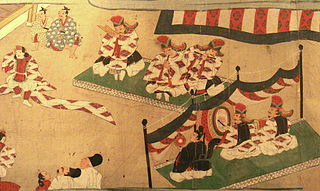
Taiko are a broad range of Japanese percussion instruments. In Japanese, the term taiko refers to any kind of drum, but outside Japan, it is used specifically to refer to any of the various Japanese drums called wadaiko and to the form of ensemble taiko drumming more specifically called kumi-daiko. The process of constructing taiko varies between manufacturers, and the preparation of both the drum body and skin can take several years depending on the method.

In Japan, music includes a wide array of distinct genres, both traditional and modern. The word for "music" in Japanese is 音楽 (ongaku), combining the kanji 音 on (sound) with the kanji 楽 gaku. Japan is the world's largest market for music on physical media and the second-largest overall music market, with a retail value of US$2.7 billion in 2017.

The shamisen, also known as sangen or samisen (all meaning "three strings"), is a three-stringed traditional Japanese musical instrument derived from the Chinese instrument sanxian. It is played with a plectrum called a bachi.

Shintaro Katsu was a Japanese actor, singer, and filmmaker. He is known for starring in the Akumyo series, the Hoodlum Soldier series, and the Zatoichi series.

Tatsu Aoki is a multi-instrumentalist trained in traditional Japanese music, educator and experimental filmmaker. In his career as Chicago's Jazz and creative improvisor, he is mostly known as a long-standing bassist for Fred Anderson and he has also worked with George Freeman, and Von Freeman in the 90s. Aoki also has curious recording projects with Malachi Favors, Roscoe Mitchell, Don Moye, Wu Man, and other internationally renowned artists. Aoki also directs cultural events that promote the history of Japanese artistic traditions and contemporary Asian influences in jazz. As the founder and artistic director of Asian Improv Arts Midwest, he hosts events such as the annual Chicago Asian American Jazz Festival and the Japanese American Service Committee's Tsukasa Taiko Legacy arts residency program.
Kakegoe (掛け声) usually refers to shouts and calls used in performances of traditional Japanese music, Kabuki theatre, and in martial arts such as kendo.

The Japan Pavilion is a Japanese-themed pavilion that is part of the World Showcase, within Epcot at Walt Disney World in Bay Lake, Florida, United States. Its location is between The American Adventure and Morocco pavilions.

Traditional Japanese music is the folk or traditional music of Japan. Japan's Ministry of Education classifies hōgaku as a category separate from other traditional forms of music, such as gagaku or shōmyō, but most ethnomusicologists view hōgaku, in a broad sense, as the form from which the others were derived. Outside of ethnomusicology, however, hōgaku usually refers to Japanese music from around the 17th to the mid-19th century. Within this framework, there are three types of traditional music in Japan: theatrical, court music, and instrumental.
Tōsha Rosen VI is a Japanese percussionist in the tradition of traditional Japanese dance and drama, the sixth iemoto (head) of the Tōsha school. He specializes in the taiko and tsuzumi, and performs as a member or leader of the hayashi in the kabuki theatre, as well as in a variety of other traditional contexts.
The Nagauta Symphony is a symphony in one movement composed in 1934 by Japanese composer Kōsaku Yamada.

A hayashi (囃子) is a group of performers who provide musical accompaniment for Japanese Nō or kabuki theatre, yose performances of rakugo, or a festival.
Shoji Kameda is a fourth-generation Japanese American musician and composer, and leading player of North American taiko. He is a founder and member of On Ensemble, a contemporary taiko quartet, and a former member of the jazz fusion group Hiroshima.

Seiichi Tanaka is the first Japan-trained teacher of kumidaiko, or taiko, in the United States and is largely regarded as the father of the art form in North America.

Kenny Endo is an American musician and taiko master. He is the leader of several taiko ensembles and regularly tours, performing traditional and contemporary taiko music. Endo is also the first non-Japanese national to receive a natori in the field of hogaku hayashi, Japanese classical drumming. Today Endo composes his own music and plays taiko professionally as a solo artist, with his ensembles, and in collaboration with other artists.
Mark Miyoshi is a Japanese-American taiko maker. He is the owner and principal craftsman at Miyoshi Daiko, based in Mt. Shasta, California.
Kelvin Underwood is an American musician specializing in the drum set and taiko, the art of Japanese drumming. After joining the Japanese taiko ensemble Ondekoza at age 19, he returned to the United States four years later to pursue a career as a professional drummer. He is a member of the Los Angeles–based contemporary taiko quartet On Ensemble and collaborates with a variety of other artists and performers. Underwood resides in Ashland, Oregon with his two children.
Jiuta (地歌/地唄/ぢうた) is a style of traditional Japanese music. In the Edo period (1603–1867), pieces in the jiuta style were played on the shamisen, and were mostly regional to Kamigata. The name jiuta means 'song' of 'a place' or 'a region', and suggests "not a song from Edo".
Stanford Taiko is a collegiate taiko group based at Stanford University. One of the first collegiate taiko groups to form in North America, it was founded in the winter of 1992 by students Ann Ishimaru and Valerie Mih as a way to share taiko with the university community. As the founding organization of the Intercollegiate Taiko Invitational, Stanford Taiko has been instrumental in the development of collegiate taiko throughout the United States, as well as the larger North American taiko community through performing at the Taiko Jam of the North American Taiko Conference. Since 2000, the group has been active in the international scene through tours and exchange concerts in countries such as Japan, China, and Thailand.
Denver Taiko is the fourth taiko group founded in North America and the first taiko ensemble outside of California, United States. The group has a close partnership with the Tri-State Denver Buddhist Temple and performs throughout Colorado and neighboring states. In 2001, Denver Taiko received the Excellence in the Arts Award from Denver Mayor Wellington Webb. Today, Denver Taiko is an ensemble of third, fourth, and fifth generation Japanese Americans with a shared interest in honoring their Japanese American cultural heritage.

Portland Taiko is a kumidaiko performance group based in Portland, Oregon, United States. Kumidaiko is the Japanese art form of ensemble drumming, also well known as "taiko", the Japanese word for drum. Portland Taiko was created in early 1994 by Ann Ishimaru and Zack Semke, both charter members of Stanford Taiko, Kyle Kajihiro, Valerie Otani, Kenji Spielman, and June Arima Schumann. Portland Taiko is an active organization to the present day and maintains professionalism in national performance tours, workshops, educational and community outreach and innovation in taiko playing. Portland Taiko is one of the only large taiko groups in the Pacific Northwest, with their closest counterpart being Seattle Kokon Taiko in Seattle, Washington.










